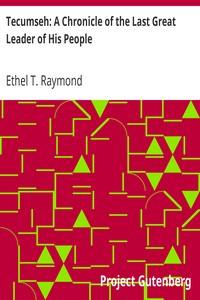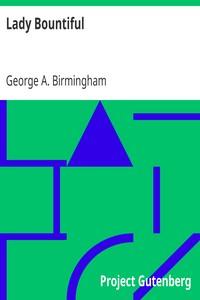Read this ebook for free! No credit card needed, absolutely nothing to pay.
Words: 63744 in 16 pages
This is an ebook sharing website. You can read the uploaded ebooks for free here. No credit cards needed, nothing to pay. If you want to own a digital copy of the ebook, or want to read offline with your favorite ebook-reader, then you can choose to buy and download the ebook.


: Tecumseh: A Chronicle of the Last Great Leader of His People Vol. 17 of Chronicles of Canada by Raymond Ethel T - Tecumseh Shawnee chief 1768-1813
THE BOYHOOD OF TECUMSEH
Three Indian figures stand out in bold relief on the background of Canadian history--the figures of Pontiac, Brant, and Tecumseh. The Ottawa chief Pontiac was the friend of the French, and, when the French suffered defeat, he plotted and fought to drive the English from the Indian country. Brant, the Mohawk, took the king's side against the Americans in the War of Independence, and finally led his defeated people to Canada that they might have homes on British soil. And Tecumseh threw in his lot with the British in the War of 1812 and gave his life in their service. But, while Pontiac fought for the French and Brant and Tecumseh for the British, it was for the lost cause of their own people that all three were really fighting; and it was for this that they spent themselves in vain.
Tecumseh, whose story we are to tell in this volume, sprang from the Shawnees, an energetic and warlike tribe of Algonquian stock. The Algonquins, whose tribal branches were scattered from Labrador to the Rockies and from Hudson Bay to North Carolina, believed that a deity presided over each of the four cardinal points of the compass. Shawan was the guardian spirit of the South; and, as the tribe to which Tecumseh belonged formerly lived south of the other tribes, its members became known as Shawanoes, or Shawnees--that is, Southerners.
Little is known of the history of the Shawnees, for they were restless bands, greater wanderers even than the generality of Indians, and their continual change of settlement baffles historical research. Upon the southern shores of Lake Erie, on the banks of the Ohio, and along the broad Mississippi, at different times they pitched their tents. The name of the river Suwanee, or 'Swanee,' corrupted from their own, marks their abode at one time in Georgia and Florida.
The Shawnees were originally divided into twelve clans, each clan adopting as its totem a reptile, bird, or animal that at some time had been regarded as a benign spirit. As a result of continual wars and wandering, however, the twelve clans had dwindled to four. Only the Mequachake, Chillicothe, Piqua, and Kiscopoke remained. In the first of these, which conducted all tribal rites, the chiefship was hereditary; in the other three it was the reward of merit.
To the Kiscopoke clan belonged Tecumseh's father, Puckeshinwau . He had been elevated to the rank of chief by his brother-warriors, and at the time of Tecumseh's birth was a powerful leader among his people. The panther was the totem of his clan. Tecumseh's mother, named Methoataske , is said to have been noted for wisdom among the women of her tribe, and her name shows that she belonged to the clan having the turtle as its totem. After much wandering, Puckeshinwau settled down in the Ohio country with his family and the band that accompanied him in his migrations. It was in the old Indian village of Piqua, about six miles south-west of the site of the present city of Springfield, Ohio, and within sound of the rushing waters of the Mad River, that he set up the wigwam in which, in the year 1768, Tecumseh first opened his eyes. We are told that a rich, wide plateau, gemmed with wild flowers, extended between the village and the river, and that precipitous cliffs rose on one side, while rolling hills crowned with tall trees completed the circle of the village.
Tecumseh was the fourth child of a family of seven. His elders were Cheeseekau, the eldest son, Tecumapease, the only daughter, and Sauwaseekau; the younger children were Nehasumo, Laulewasikaw, and Kumshakaw. The two last were twins; and twins were held in superstitious awe by the Indians, who feared them as possessed of occult power, and frequently put one or both to death. In this instance no such fate befell the children. Kumshakaw evinced none of the dreaded attributes, and lived to a ripe old age, but Laulewasikaw, by his practice of magic and claims of supernatural knowledge and power, as we shall see later, bore out the ancient belief.
Tecumseh in his early days was left largely to the care of his sister, Tecumapease. Thus between the two there arose a strong attachment which lasted until Tecumseh's death. From the well-known Indian practices in relation to the bringing up of young children we can imagine how the days of his infancy were passed. When not rolling on the ground, the child would be closely confined in his curious cradle, a sack made from the skin of an animal and bound to a thin, straight board, somewhat larger than his body. Great care would be taken to keep straight the infant limbs, that their symmetry might be preserved in later life. This was the first stage in the making of an Indian stoic. Every part of the cradle was symbolical. That the child's life might be preserved, the heart of a tree was used for the cradle board. Along the wooden bow above the child's head, which symbolized the sky, zigzag furrows were cut to represent lightning, the power of which was designated by suspended arrows. Through holes in the upper part of the board was threaded a leather thong, or burden-strap, which Tecumapease passed about her forehead when carrying the papoose on her back, or which the mother fastened to the pommel of her saddle when making long journeys. It served also to hang the cradle to the branch of a tree, when the child swayed backwards and forwards with the motion of the bough while the wind crooned him to sleep. The cradle would sometimes be placed upright against a tree-trunk, so that Tecumseh's eyes might follow Tecumapease as she helped to grind the corn in a hollow stone or sift it through baskets; or, again, while she mixed the meal into cakes, and carefully covered them with leaves before baking them in the ashes.
Sometimes Tecumapease would carry Tecumseh on her back to where Methoataske worked in the field with the other women of her tribe. Like them, from bearing heavy burdens and doing the drudgery of the camp, Tecumapease was strong and sturdy rather than graceful. Her hair, black and glossy as a raven's wing, hung below her waist in a heavy braid. The short, loose sleeves of her fringed leather smock gave freedom to her strong brown arms. A belted skirt, leggings, and embroidered moccasins completed her costume. On special occasions, like other Indian women, she adorned herself with a belt and collar of coloured wampum, weaving strands of it into her hair; and sometimes a necklace of polished elk-teeth gleamed on her dusky throat. When Tecumseh had learned the use of his legs, he would romp about the camp with the other black-eyed children of his tribe. He watched his father, Puckeshinwau, make the flint arrow-head and split the wooden shaft to receive it, bind it firmly with a thong, and tip the other end of the shaft with a feather to wing it on its flight; and saw the men build the birch canoe, so light that one man could shoulder it, yet strong enough to carry a heavy load.
It was we who so kindly received Europeans on their first arrival into our own country. We took them by the hand and bade them welcome, to sit down by our side and live with us as brothers; but how did they requite our kindness? They at first asked only for a little land on which to raise bread for their families and pasture their cattle, which we freely gave them. They saw the game in the woods which the Great Spirit had given us for our subsistence, and they wanted it too. They penetrated into the woods in quest of game, they discovered spots of land which they also wanted, and because we were loath to part with it, as we saw they already had more than they had need of, they took it from us by force and drove us to a great distance from our homes.
At this time there was not community of interest or united action among the colonies. Pennsylvania and Virginia each claimed authority in the Indian country. The Pennsylvanians viewed the country from a trading point of view; the Virginians viewed it as a field for settlement. So bitter was the feud between the two colonies that for a time civil strife was imminent. And while this family quarrel was at its height, the Indian scalping raids grew in frequency and violence; and the memory of the Pontiac War was still fresh in the minds of the frontiersmen. Many Pennsylvanians in the west became alarmed, and soon the passes of the Alleghanies were filled with fugitive settlers returning to their former homes. The Virginians of Kentucky were made of sterner stuff. Lord Dunmore, the royal governor of Virginia, was ambitious for his colony, and determined to make good by the sword Virginia's claim to the region of which Fort Pitt was the centre; and, under leaders like the veteran borderers, Michael Cresap and Daniel Boone, and the youthful and audacious hunter and surveyor, George Rogers Clark, the Virginians strengthened their fortified villages and led successful raids against the tribes north of the Ohio.
For some time the Shawnees had been at peace, but in the latter part of April 1774, when two Indians suspected of horse-stealing were put to death near Wheeling, on the Ohio, they threatened war. A little later a party of Virginians fired upon a band of Indians, and killed several. Again, thirty-two white men, hitherto friends of the Indians, set out to attack a hunting-party of warriors camped on the Ohio. A friendly squaw warned them to return, as the Indians, who were carousing, had vowed vengeance for the death of their tribesmen. But the white men had determined to destroy the band; and by the promise of more rum they enticed a number of the Indians to cross the river to their camp, where they put all to death, with the exception of one child, not even sparing the kindly counsellor. Other Indians across the river, alarmed by the sound of shooting, sent two canoes to the rescue, but the whites drawn up on shore fired upon their occupants, killing twelve and wounding several more. The Indians were further incensed by the murder of Bald Eagle, a sachem of the Delawares, who was attacked and scalped while returning from a visit to a fort at the mouth of the Great Kanawha, and whose body, placed in an upright position in his canoe, was found drifting down the Ohio by his enraged followers. Even Silver Heels, a favourite Shawnee chief, barely escaped death. While guiding some white settlers along unfamiliar trails on their way to safety, he was severely wounded by the bullets of other whites waiting for him in ambush.
Free books android app tbrJar TBR JAR Read Free books online gutenberg
More posts by @FreeBooks

: A Commentary on Herodotus by How W W Walter Wybergh Wells J Joseph - History Ancient; Herodotus. History


: Doktoro Jekyll kaj Sinjoro Hyde by Stevenson Robert Louis Mann William W Translator Morrison William Translator - Science fiction; Horror tales; London (England) Fiction; Physicians Fiction; Psychological fiction; Self-experimentation in medicine Fiction;






